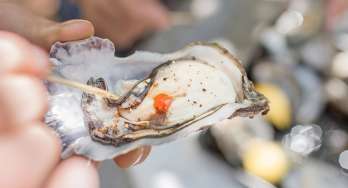Why do people go to Poor Knights Island?
People visit the Poor Knights Islands Marine Reserve for its world-class underwater environment. The area is a marine reserve and biodiversity hotspot, attracting snorkellers, scuba divers, kayakers, and marine life enthusiasts. The waters around the islands are known for high visibility, vibrant reef systems, and a wide range of species – from schooling fish and rays to nudibranchs and occasional dolphins or orca.
The islands are also home to geological formations like arches, tunnels, and caves, including the well-known Rikoriko Cave, considered one of the largest sea caves in the world by volume. Boat tours often include time to explore these formations by kayak or swim-through.
Though landings are not permitted, the islands are also significant from a cultural and botanical perspective. The steep cliffs are home to native seabirds and the seasonal Poor Knights lily (Xeronema callistemon), which blooms with bright red flowers in spring. The islands also hold cultural importance as wāhi tapu (sacred sites) to local Māori iwi.
How long should I spend at Poor Knights Island?
Most people visit the Poor Knights Islands Marine Reserve on a full-day Tutukaka to Poor Knights boat tour. These typically run from mid-morning to late afternoon and include:
-
Travel time to and from the islands (45–60 minutes each way)
-
Snorkelling or diving sessions
-
Time to explore sea caves, including Rikoriko Cave
-
Onboard lunch breaks and rest periods
Some travellers choose to return for a second day if interested in multiple dives or exploring different sites. Overnight stays on the islands themselves are not permitted due to their protected status.
Why is it called Poor Knights Island?
The name “Poor Knights Islands” was given by Captain James Cook in 1769. The most widely accepted theory is that the islands’ shape reminded him of a traditional English dish called “poor knights pudding” – a type of fried bread with wine and sugar, similar to French toast. He thought the group of islands resembled slices of the dish arranged on a plate.
Alternative theories suggest the name may relate to the rugged cliffs resembling medieval knights in armour, but the food-based explanation remains the most commonly cited.
Poor Knights Islands diving
-
Book in advance, especially during summer, as trips can fill quickly.
-
Check experience levels – many dive sites are suitable for beginners, but some are better suited to advanced divers.
-
Gear hire is available from most operators, but you’re welcome to bring your own.
-
Follow marine reserve rules – touching or collecting marine life is not permitted.
-
Conditions can vary, so listen to your guides and stay within your comfort level, particularly in open caves or deeper water.
-
Underwater visibility is usually excellent, often 20–30 metres. Bring a dive torch to explore caves and arches more clearly.
Poor Knights Islands snorkelling
-
Most day tours include snorkelling gear, wetsuits, and flotation aids – check with your operator when booking.
-
No experience is needed – snorkelling here is suitable for beginners, with calm bays and clear water.
-
Stay close to the boat unless advised otherwise. Guides usually point out the best areas for marine life.
-
Look for rocky reef edges, where fish tend to gather. You might also spot rays, kelp forests, or even dolphins.
-
Don’t touch or disturb marine life – the area is a protected reserve.
-
Wetsuits are recommended year-round, even in summer, as the water can be cooler than expected.

How to get to Poor Knights Island
From Auckland to Tutukaka: Drive north on State Highway 1 (SH1) for around 200 km (3.5 hours). Before reaching Whangārei, turn right onto Ngunguru Road, following signs for the Tutukaka Coast. Continue toward Tutukaka Marina, where most dive and snorkel tours depart.
From Tutukaka to Poor Knights Islands: There is no direct access to the islands by private vessel or land transport. You’ll need to join a licensed boat tour or dive/snorkel operator departing from the marina. Travel time to the islands is approximately 45 minutes to 1 hour, depending on conditions.
Operators generally provide gear hire, lunch, and safety briefings, making the experience accessible to first-time snorkellers as well as certified divers.
Best time to visit Poor Knights Island
Best time of year: The best time to visit the Poor Knights Islands is summer and early autumn (December to April), when sea temperatures reach 20–23 °C and visibility is at its best. This is the ideal season for:
-
Snorkelling and diving
-
Kayaking through arches and caves
-
Viewing seasonal Poor Knights Island wildlife, including rays, large schools of fish, and occasional dolphins or orca
-
Seeing the Poor Knights lily spring bloom (September–November)
Tours run year-round, but conditions in winter and early spring can be cooler and more variable.
Best time of day: Tours usually depart in the morning (9–10 am), as sea conditions are typically calmer earlier in the day. Most return in the mid-to-late afternoon. Morning departures are preferable for a smoother ride and better underwater visibility.
Weather at Poor Knights Island
The Poor Knights Islands enjoy a mild, subtropical marine climate:
-
Summer (Dec–Feb): 20–26 °C
-
Autumn/Spring: 16–22 °C
-
Winter (Jun–Aug): 12–16 °C
Sea temperatures are warmest from December to April. Rain is possible year-round, but most days are suitable for on-water activities, especially in summer.
Best place to park your campervan at Poor Knights Island
As the islands themselves are not accessible by road, campervan travellers should park at or near Tutukaka Marina, the departure point for tours.
-
Parking is limited, especially during summer, so arrive early
-
Some public parking is available near the marina and on adjacent streets
-
There are no long-term or overnight parking options for campervans
-
Public toilets and cafés are available near the departure zone
If you're staying overnight in the area, several campgrounds and holiday parks nearby offer campervan facilities within 15–20 minutes of the marina.



